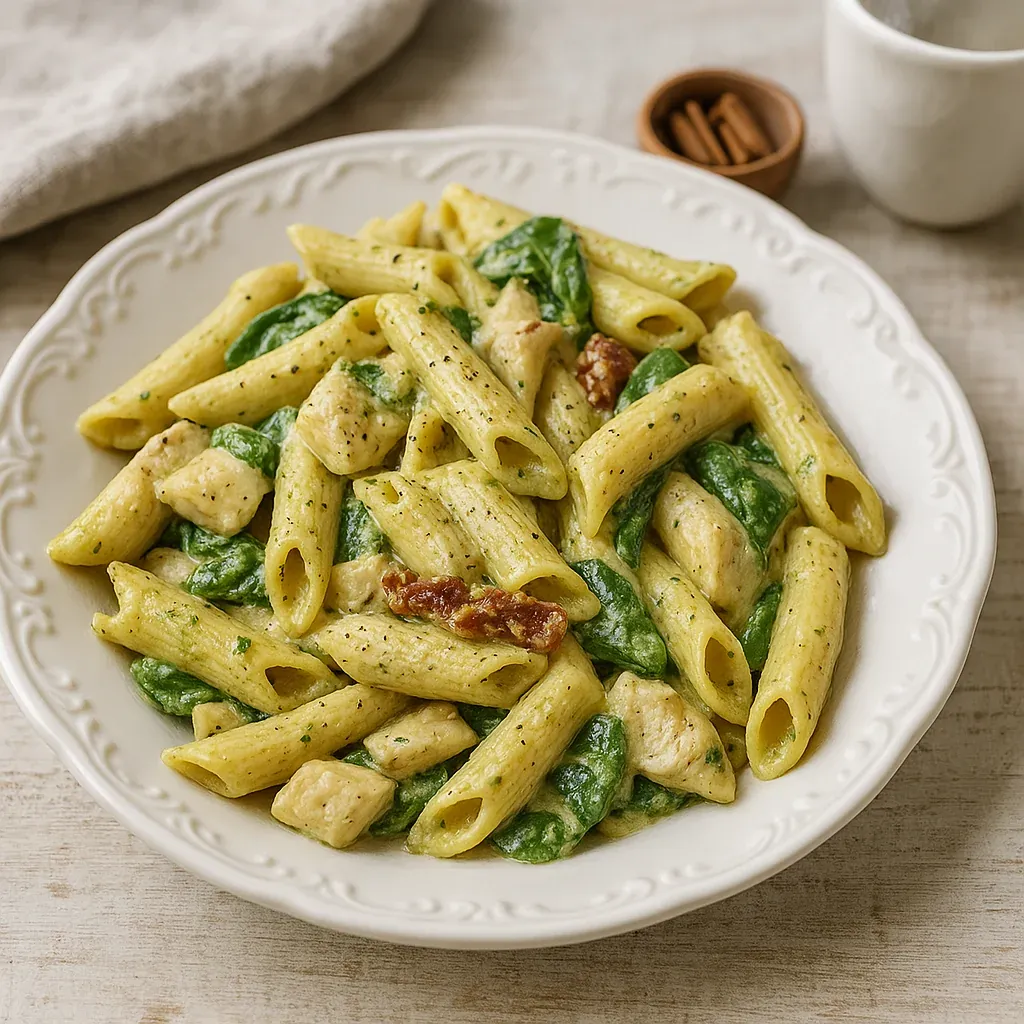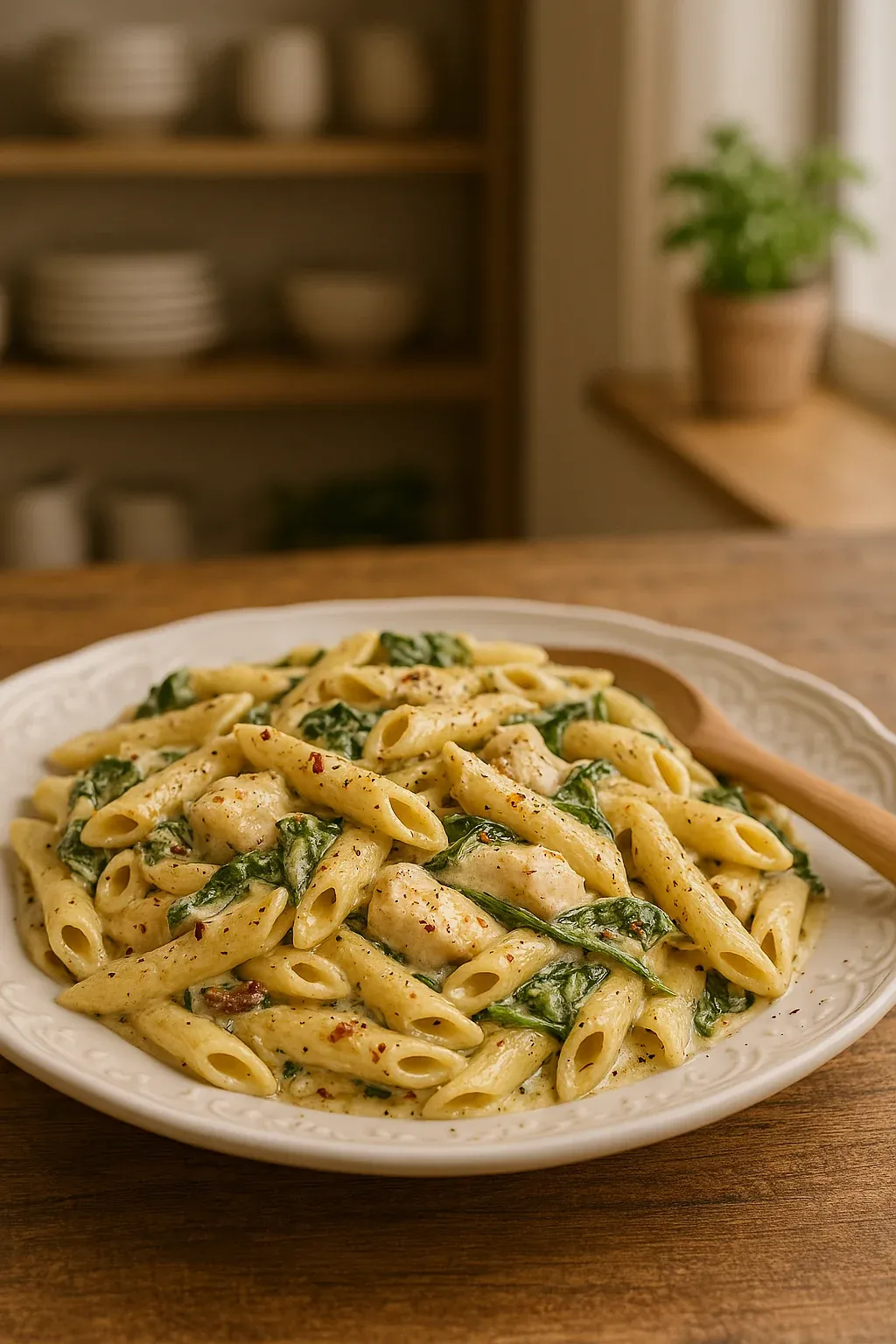 Pin
Pin
This hearty One Pot Creamy Pesto Chicken Pasta transforms simple pantry ingredients into a luxurious dinner that's ready in just 25 minutes. The velvety sauce coats each piece of pasta perfectly, while tender chicken and optional add-ins create a complete meal that feels special enough for guests but easy enough for weeknights.
I created this recipe during a busy week when I needed something impressive but effortless. My family now requests it regularly, and it's become my go-to when entertaining friends who always leave asking for the recipe.
- Boneless skinless chicken breasts: cut into 1-inch pieces ensure even cooking and tender bites throughout the dish
- Butter: creates a rich foundation and helps brown the chicken for deeper flavor
- Fresh garlic: adds aromatic depth that elevates the entire dish
- Penne pasta: with ridges captures the creamy sauce in every bite
- Chicken broth: seems minimal but perfectly cooks the pasta while forming the sauce base
- Milk and cream cheese: create the silky smooth texture that makes this dish so comforting
- Basil pesto: provides herby brightness and signature flavor without extra effort
- Grated Parmesan: adds salty umami notes that enhance every bite
- Black pepper and crushed red pepper: offer a perfect balance of heat
- Optional fresh spinach and sun-dried tomatoes: add color, nutrition and textural contrast
Step-by-Step Instructions
- Brown the Chicken:
- Heat butter in a large skillet over medium-high heat until melted and foamy. Add chicken pieces in a single layer, allowing them to cook undisturbed for 2-3 minutes until golden brown on the bottom. Flip pieces and continue cooking until nearly done, about 3-4 minutes more. The golden crust on the chicken is crucial for building flavor throughout the dish.
- Add Aromatics:
- Reduce heat to medium and add minced garlic to the skillet with the chicken. Cook for just 30-60 seconds, stirring constantly until fragrant but not browned. The garlic should become aromatic but not burn, which would add bitterness to the final dish.
- Create the Base:
- Add uncooked penne pasta to the skillet, then pour in chicken broth. Stir well to ensure all pasta is submerged as much as possible. Cover the skillet with a tight-fitting lid and bring to a simmer. The steam trapped inside will help cook the pasta evenly.
- Cook the Pasta:
- Maintain a consistent simmer for about 8-10 minutes, stirring every 2 minutes to prevent sticking. Continue cooking until pasta is al dente and most of the liquid has been absorbed. The pasta should still have some bite to it, as it will continue cooking slightly in the next steps.
- Create the Creamy Sauce:
- Reduce heat to low. Add milk and cream cheese, stirring continuously until cream cheese has completely melted and incorporated into the sauce. The transformation from brothy to creamy happens quickly at this stage.
- Finish the Dish:
- Stir in pesto, grated Parmesan, black pepper, and crushed red pepper flakes if using. Mix thoroughly until everything is well combined and heated through. If adding spinach and sun-dried tomatoes, fold them in now and allow the residual heat to wilt the spinach.

The fresh basil in the pesto is what truly makes this dish special for me. I discovered this recipe during a particularly cold winter when fresh herbs were hard to come by, and it instantly transported me to summer. My children now associate this pasta with our Friday movie nights, where we pile onto the couch with bowls of this creamy comfort food.
Pasta Selection Matters
The shape and type of pasta you choose significantly impacts the success of this one-pot method. Penne works beautifully because of its cooking time and ability to hold sauce. While rotini and bow ties can work well too, be cautious about substituting pasta types. Gluten-free, rice, or chickpea pastas absorb liquid differently and may not produce the same creamy results. Whole wheat pasta generally requires more liquid and longer cooking times, so adjustments would be necessary.

The One-Pot Technique
The success of this dish relies heavily on understanding the one-pot pasta method. Unlike traditional pasta cooking where we use abundant water, this technique uses a precise amount of liquid that gets absorbed while simultaneously creating the sauce. Quality cookware makes a tremendous difference here. Heavy-bottomed pans distribute heat evenly, preventing some pasta from overcooking while other pieces remain raw. A burner matched to your pan size further ensures even heat distribution. The liquid should maintain a steady simmer throughout cooking—too low and your pasta becomes mushy, too high and the liquid evaporates before pasta tenderizes.
Making It Your Own
This recipe welcomes personalization based on what you have available. Beyond spinach and sun-dried tomatoes, many readers have reported success with sautéed mushrooms, bell peppers, or even artichoke hearts. For a spicier version, increase the red pepper flakes or add a dash of hot sauce to the finished dish. If you prefer a less creamy consistency, reduce the cream cheese slightly. During summer months, I often stir in halved cherry tomatoes right at the end for bright bursts of flavor. The adaptability makes this recipe perfect for using up vegetables about to go past their prime.
Leftovers Strategy
While this dish shines brightest when freshly made, proper storage and reheating can maintain much of its appeal. Store cooled pasta in airtight containers in the refrigerator for up to three days. When reheating, the key is adding moisture back into the dish. A splash of chicken broth or milk stirred in before gentle reheating prevents the pasta from becoming dry and gummy. Microwave on medium power with a damp paper towel covering the dish, or reheat slowly on the stovetop, stirring frequently. I sometimes transform leftovers into a new dish by adding extra broth to create a soup-like consistency, finishing with a fresh sprinkle of Parmesan.
Recipe FAQs
- → What type of pasta works best?
Penne pasta is ideal for this recipe as its ridges hold the creamy sauce well. Bowties or rotini are also good alternatives.
- → Can I use chicken thighs instead of chicken breasts?
Yes, boneless chicken thighs work well in this recipe. Just ensure they are cut into evenly-sized pieces for even cooking.
- → How can I make this dish vegetarian?
You can skip the chicken and add more vegetables like sautéed mushrooms or zucchini. Ensure the ratio of pasta and broth remains consistent.
- → Can I prepare this recipe ahead of time?
This dish is best served fresh, but leftovers can be stored in an airtight container in the fridge for up to 3 days. Add extra broth when reheating to loosen the sauce.
- → Can I use homemade pesto instead of store-bought?
Absolutely! Homemade basil pesto works beautifully in this dish, offering fresh and vibrant flavors.
- → What sides pair well with this dish?
Serve this with homemade garlic bread, a green salad with balsamic vinaigrette, or roasted vegetables like carrots or mushrooms.
- → How do I store and reheat leftovers?
Store leftovers in the fridge for up to 3 days in an airtight container. Reheat in the microwave or on the stovetop with a splash of broth to restore the sauce's consistency.
- → Can I freeze this dish?
You can freeze the dish for up to three months. However, cream-based sauces may separate, and the pesto may darken upon thawing.
